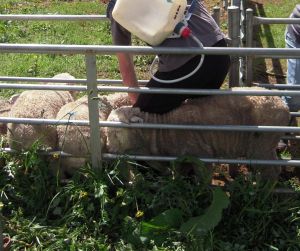Recent worm count and egg count results throughout the south east of Australia suggest that Barbers Pole worm (Haemonchus contortus) will be a challenge this spring and summer on farms that traditionally may not have seen issues previously with this parasite.
Department of Primary Industries (DPI) District Veterinary Officer Jim Walsh said sheep movements to rebuild flock numbers, trade stock or graze stubble had seen the parasite introduced to properties where it may not have been seen before. “Barbers Pole worm is commonly found in sheep production areas with a summer rainfall such as the northern areas of NSW or irrigation areas,” Dr Walsh said. “During warm, moist conditions, eggs hatch into larvae which are eaten by sheep during grazing. “With the ability to reproduce in massive numbers, as many as 10,000 eggs per day and reaching maturity at only 21 days after ingestion from pasture, numbers of adult worms can build up extremely quickly. |  |
Dr Walsh said the worms suck blood leading to anaemia, weakness and bottle-jaw but not necessarily weight loss or diarrhoea.
“Sheep do not necessarily scour and sometimes can have a very large population of worms without having an egg count if the worms are immature,” he said. Dry conditions and frost reduce the survival of larvae on pasture which is why it is not seen as often in winter rainfall areas. Eggs are extremely hardy and a proportion can survive in dense pastures, until hatching in the spring. The recent wetter-than-normal summers have also allowed populations to survive.”
| In recent years, Barbers Pole has developed resistance on some properties to Mectin and Closantel drenches traditionally used for control. | "Worms suck blood leading to anaemia, weakness and bottle-jaw." |
Drenching of introduced sheep that are carrying resistant worms may not prove effective and the sheep may also contaminate pastures.
Producers are encouraged to contact their local animal health advisors for advice on an effective treatment and control program, these should include:
- quarantine drenching introduced sheep with an effective drench;
- monitoring with worm egg counts;
- knowing your drench resistance status (knowing what drenches work); and
- preparing clean paddocks for sheep to be moved to after drenching.
Wormboss.com.au is a very useful source for further information about this potentially significant problem.



